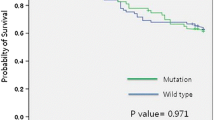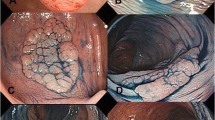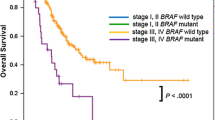Abstract
Background and aims
Many investigators have reported flat and depressed lesions as a new type of precursor of colorectal cancer. In our previous study, we determined that mutations in the BRAF gene may contribute to colorectal carcinogenesis by inhibiting apoptosis. However, the relationship among BRAF mutations, morphology and apoptosis in early colorectal cancer has not been clear. Therefore, gene alternation, morphology, and apoptosis in early colorectal cancer were investigated.
Materials and methods
Forty-five flat and depressed early colorectal cancer samples and 43 polypoid early colorectal cancer samples were analyzed. Mutations in the BRAF gene and the K-ras gene were examined by direct sequence analysis, and proliferative activity and induction of apoptosis were evaluated using immunohistochemical examination.
Results findings
BRAF mutations were found in 5 (11.1%) of 45 flat and depressed early colorectal cancer samples. No BRAF alteration was found in polypoid early colorectal cancer samples. Mutations in the K-ras gene were detected in 13 (30.2%) of 43 polypoid early colorectal cancer samples. The rate of submucosal invasion of the samples with BRAF mutations was significantly higher than that of the samples with K-ras mutations (p < 0.05).
Interpretation/conclusions
BRAF and K-ras mutations were independent factors that influenced morphology in early colorectal cancer. In this study, the relationship between BRAF mutation and apoptosis is not so clear, but BRAF mutations and inhibition in apoptosis may play an important role in the developmental process of flat and depressed early colorectal cancer.


Similar content being viewed by others
Abbreviations
- PCR:
-
polymerase chain reaction
- ssDNA:
-
single-stranded DNA
References
Morson B (1974) President’s address. The polyp–cancer sequence in the large bowel. Proc R Soc Med 67:451–457
Muto T, Bussey HJ (1975) The evolution of cancer of the colon and rectum. Cancer 36:2251–2270
Muto T, Kamiya J (1985) Small “flat adenoma” of the large bowel with special reference to its clinicopathologic features. Dis Colon Rectum 28:847–851
Kudo S (1993) Endoscopic mucosal resection of flat and depressed types of early colorectal cancer. Endoscopy 25:455–461
Jaramillo E, Watanabe M (1995) Flat neoplastic lesions of the colon and rectum detected by high-resolution video endoscopy and chromoscopy. Gastrointest Endosc 42:114–122
Tsuda S, Veress B (2002) Flat and depressed colorectal tumours in a southern Swedish population: a prospective chromoendoscopic and histopathological study. Gut 51:550–555
Rembacken BJ, Fujii T (2000) Flat and depressed colonic neoplasms: a prospective study of 1000 colonoscopies in the UK. Lancet 355:1211–1214
Davies H, Bignell GR (2002) Mutations of the BRAF gene in human cancer. Nature 417:949–954
Chan TL, Zhao W (2003) BRAF and KRAS mutations in colorectal hyperplastic polyps and serrated adenomas. Cancer Res 63:4878–4881
Kambara T, Simms LA (2004) BRAF mutation is associated with DNA methylation in serrated polyps and cancers of the colorectum. Gut 53:1137–1144
Konishi K, Yamochi T (2004) Molecular differences between sporadic serrated and conventional colorectal adenomas. Clin Cancer Res 10:3082–3090
Bos JL, Fearon ER (1987) Prevalence of ras gene mutations in human colorectal cancers. Nature 327:293–297
Forrester K, Almoguera C (1987) Detection of high incidence of K-ras oncogenes during human colon tumorigenesis. Nature 327:298–303
Fujimori T, Satonaka K (1994) Non-involvement of ras mutations in flat colorectal adenomas and carcinomas. Int J Cancer 57:51–55
Minamoto T, Sawaguchi K (1994) Infrequent K-ras activation in superficial-type (flat) colorectal adenomas and adenocarcinomas. Cancer Res 54:2841–2844
Yuen ST, Davies H (2002) Similarity of the phenotypic patterns associated with BRAF and KRAS mutations in colorectal neoplasia. Cancer Res 62:6451–6455
Nagasaka T, Sasamoto H (2004) Colorectal cancer with mutation in BRAF, KRAS, and wild-type with respect to both oncogenes showing different patterns of DNA methylation. J Clin Oncol 22:4584–4594
Ikehara N, Semba S (2005) BRAF mutation associated with dysregulation of apoptosis in human colorectal neoplasms. Int J Cancer 115:943–950
Konishi K, Takimoto M (2006) BRAF mutations and phosphorylation status of mitogen-activated protein kinases in the development of flat and depressed-type colorectal neoplasias. Br J Cancer 94:311–317
Schlemper RJ, Riddell RH (2000) The Vienna classification of gastrointestinal epithelial neoplasia. Gut 47:251–255
Dixon MF (2002) Gastrointestinal epithelial neoplasia: Vienna revisited. Gut 51:130–131
Yasui W, Akama Y (1996) Expression of cyclin-dependent kinase inhibitor p21WAF1/CIP1 in non-neoplastic mucosa and neoplasia of the stomach: relationship with p53 status and proliferative activity. J Pathol 180:122–128
Sakashita M, Aoyama N (2000) Flat-elevated and depressed, subtypes of flat early colorectal cancers, should be distinguished by their pathological features. Int J Colorectal Dis 15:275–281
Minamoto T, Mai M (1993) Early invasive colorectal carcinomas metastatic to the lymph node with attention to their nonpolypoid development. Am J Gastroenterol 88:1035–1039
Minamoto T, Sawaguchi K (1994) Superficial-type adenomas and adenocarcinomas of the colon and rectum: a comparative morphological study. Gastroenterology 106:1436–1443
Kudo S, Tamura S (1995) Depressed type of colorectal cancer. Endoscopy 27:54–57
Kolch W (2000) Meaningful relationships: the regulation of the Ras/Raf/MEK/ERK pathway by protein interactions. Biochem J 351(Pt 2):289–305
Peyssonnaux C, Eychene A (2001) The Raf/MEK/ERK pathway: new concepts of activation. Biol Cell 93:53–62
Ikenoue T, Hikiba Y (2003) Functional analysis of mutations within the kinase activation segment of B-Raf in human colorectal tumors. Cancer Res 63:8132–8137
Hingorani SR, Jacobetz MA (2003) Suppression of BRAF(V599E) in human melanoma abrogates transformation. Cancer Res 63:5198–5202
Ozawa A, Konishi F (2000) Apoptosis and its regulation in flat-type early colorectal carcinoma: comparison with that in polypoid-type early colorectal carcinoma. Dis Colon Rectum 43:S23–S28
Nomura M, Watari J (2000) Morphogenesis of nonpolypoid colorectal adenomas and early carcinomas assessed by cell proliferation and apoptosis. Virchows Arch 437:17–24
Acknowledgments
The authors express great thanks to Miss Satomi Shigeta, Dr. Souzana Deenitchina, the staff of the Department of Endoscopy, the Division of Surgical Pathology, Department of Biomedical Informatics, Kobe University Graduate School of Medicine.
Author information
Authors and Affiliations
Corresponding author
Rights and permissions
About this article
Cite this article
Yoshida, S., Ikehara, N., Aoyama, N. et al. Relationship of BRAF mutation, morphology, and apoptosis in early colorectal cancer. Int J Colorectal Dis 23, 7–13 (2008). https://doi.org/10.1007/s00384-007-0349-0
Accepted:
Published:
Issue Date:
DOI: https://doi.org/10.1007/s00384-007-0349-0




